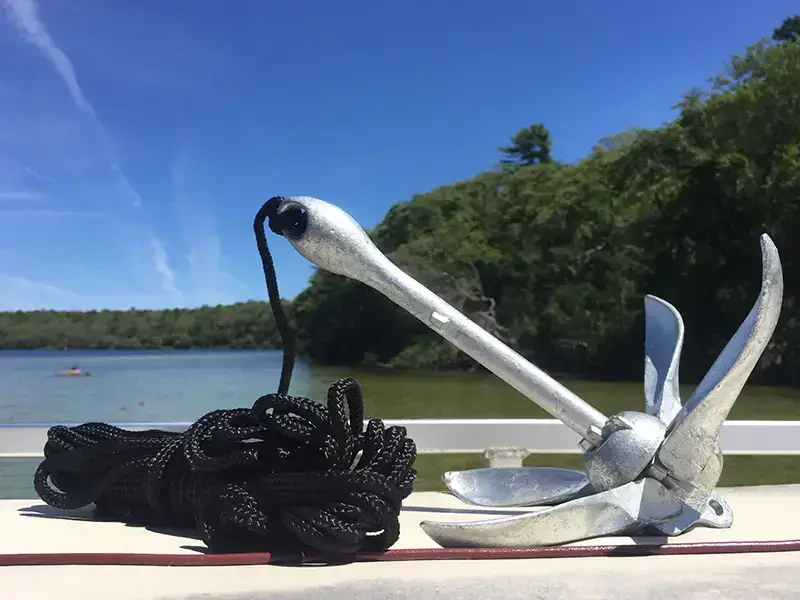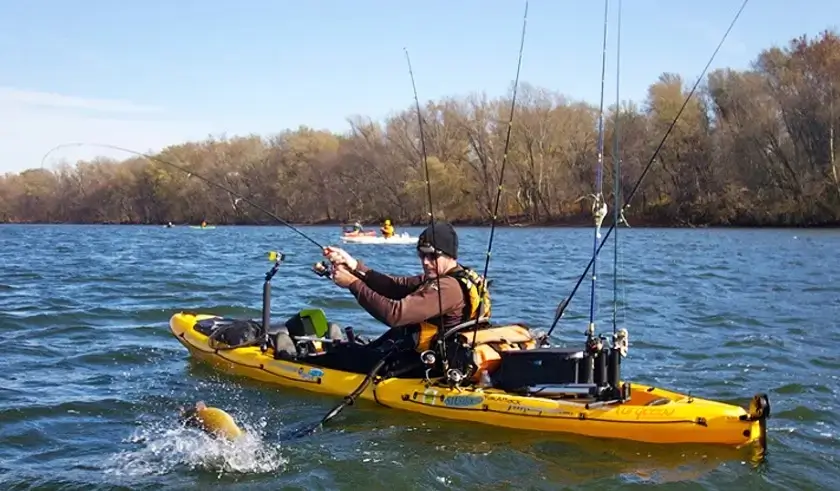When you’re out on the open water, you need to have confidence in your anchor. Choosing the wrong size can lead to problems, from being unable to hold your kayak in place to dragging and damaging the seabed.
This blog post will tell you what size anchor for kayak to use and how to choose the right one for your needs. We’ll also discuss some tips on attaching it correctly so you can stay safe while paddling.
Why Do Kayaks Require Anchors?

One of the most important pieces of kayak fishing gear is the anchor. Unfortunately, many new kayak anglers don’t realize the importance of having a good anchoring system.
A properly functioning anchor will keep you in place so you can fish without having to paddle to stay in one spot constantly.
This is especially important when fishing in windy conditions or around structures. In addition, a good anchor will help you stay safe if you capsize or fall out of your kayak.
A few different types of anchors can be used on a kayak. The most popular type is the folding grapnel anchor. This type of anchor is easy to store on your kayak and is very effective in most conditions.
Another type of anchor used on a kayak is the Danforth anchor. This type of anchor is great for fishing in sand or mud bottom areas.
The Danforth anchor has a fluke design that helps it dig into the bottom and hold your kayak in place.
What Size Anchor for Kayak
Kayaking is a fantastic way to spend time on the water, whether fishing, exploring, or enjoying the scenery. But before you can start paddling, you need to choose the right anchor for your kayak.
There are a few factors to consider when choosing an anchor for your kayak, including the size and weight of your kayak, the type of bottom you’ll be anchoring in, and the conditions you’ll be paddling in.
The first factor to consider is the size and weight of your kayak. A heavier kayak will need a bigger anchor to hold it in place, while a lighter kayak can get away with a smaller anchor. A 1 1/2- to 3-pound folding grapnel anchor is popular among kayakers. In addition, it is simple to store.
The next factor to consider is the type of bottom you’ll be anchoring in. For example, if you’re paddling in shallow water with a sandy bottom, you’ll need a different anchor than paddling in deep water with a rocky bottom.
You’ll need an anchor to dig into the sand and hold your kayak in place for a sandy bottom. A folding grapnel anchor is a good option.
You’ll need an anchor to grip the rocks and hold your kayak in place for a rocky bottom. A fluke anchor is a good option for this type of bottom.
The last factor to consider is the conditions you’ll be paddling in. If you’re paddling in calm water, you won’t need as big of an anchor as if you’re paddling in windy or wavy conditions.
In calm water, a small folding grapnel anchor should do the trick. However, you’ll need a bigger anchor to keep your kayak from drifting in windy or wavy conditions. A Danforth anchor is a good option for these conditions.
What Are the Different Types of Anchors Available?
Anchors come in all shapes and sizes, but there are three primary types of anchors that you’ll encounter while kayak fishing: fluke anchors, grapnel anchors, and deadweight anchors.
- Fluke anchors are the most popular anchor for kayaks, as they’re incredibly versatile and easy to use. They work best in sandy or muddy bottoms and can be stowed away easily when not in use.
- Grapnel anchors are a good choice for rocky bottoms, as their multiple points of contact ensure that they’ll stay put. However, they can be a bit more difficult to set up and take down.
- Deadweight anchors are the heaviest anchors and are best suited for windy conditions. They’re also the most difficult to set up and take down, but they’ll keep your kayak stationary in even the roughest waters.
No matter which type of anchor you choose, test it out in calm waters before heading out into the open sea. And always remember to pack an extra line and a few spare anchors, just in case.
How to Use an Anchor Effectively

Anchors are one of the most useful tools in a sailor’s arsenal. They provide a way to keep your vessel secure while away from it and can be used in various situations.
Here are some tips on how to use an anchor effectively:
- First, choose the right type of anchor for the job. There are four main types of anchors: Danforth, plough, grapnel, and mushroom. Each has its strengths and weaknesses, so it’s important to choose the right one for the job at hand.
- Set your anchor properly. This means making sure that it’s the correct depth for the water you’re in and that there’s enough chain or rope attached to it.
- Monitor your anchor. Even the best-set anchor can come loose if the conditions are right. So check on it regularly to ensure that it’s still holding fast.
- Know how to retrieve your anchor. This is especially important if you’re anchoring in a crowded area. Also, be sure that you know how to release your anchor quickly to don’t cause any damage to nearby vessels.
With these tips in mind, you’ll be able to use your anchor effectively and keep your vessel safe while you’re away from it.
When Should I Choose a Drift Anchor or Drogue?
There are a few things to consider when deciding to use a drift anchor or drogue.
The first is the size of your kayak. If you have a small kayak under 12 feet, you probably won’t need a drift anchor or drogue.
The second thing to consider is the wind and waves. If the wind and waves are light, you probably won’t need a drift anchor or drogue.
The third thing to consider is the current. If the current is strong, you might want to consider using a drift anchor or drogue.
If you’re still unsure whether or not you should use a drift anchor or drogue, the best thing to do is talk to an experienced kayaker or someone at your local kayak shop. They’ll be able to help you make the best decision for your situation.
Tips for Anchoring Your Kayak in Different Types of Water
One of the great things about kayaking is that it can be done in so many different types of water, from calm lakes to rushing rivers.
But no matter where you’re paddling, you’ll need to know how to anchor your kayak to enjoy a peaceful float or take a break onshore.
Here are some tips for anchoring your kayak in different types of water:
- You can use a simple anchor line with a loop at one end for calm water. Run the line through the loop and tie it off to your kayak’s stern (back end). The other end of the line should be tied to an anchor that is heavy enough to keep your kayak in place but light enough to carry easily.
- In moving water, you’ll need a different type of anchor. A “drift” or “river” anchor is designed to catch on rocks or other objects in the water and hold your kayak in place. To use one of these anchors, tie it to the front of your kayak and let out enough line so that the anchor can reach the bottom.
- You can also use a “stake out” pole to anchor your kayak in calm and moving water. Tying one end of a line to your kayak and the other to a long pole. Drive the pole into the ground at the shoreline, careful not to hit any underwater obstacles.
With these tips, you’ll be able to anchor your kayak no matter where you’re paddling. Just be sure to practice anchoring in different types of water before you head out on a long trip, so you’ll be prepared for anything.
The Benefits of Using a Larger Anchor in Kayak
When you are out kayaking, it is important to have an anchor to keep you secure in bad weather or other unforeseen circumstances.
A larger anchor will provide more holding power and keep you safer while enjoying your time on the water. Here are some other benefits of using a larger anchor for your kayak:
- You will have more peace of mind knowing that your anchor is large enough to keep you safe in case of an emergency
- A larger anchor will also give you more options for where you can set it up. This can be especially helpful if you are kayaking in an area with many rocks or other obstacles.
- Larger anchors are also less likely to get tangled in the weeds or other debris found in waterways.
- They are also easier to retrieve if you need to move your kayak to a different location.
These factors make using a larger anchor kayak a wise choice for anyone who wants to enjoy their time on the water without worry.
So, the next time you are out kayaking, bring along a larger anchor to keep yourself safe and secure.
Conclusion
After researching and consulting with experts, we’ve concluded that there is no definitive answer to what size anchor you should use for your kayak.
It depends on various factors, such as the wind and wave conditions, the type of bottom you’re anchoring in, and the size and weight of your kayak.
